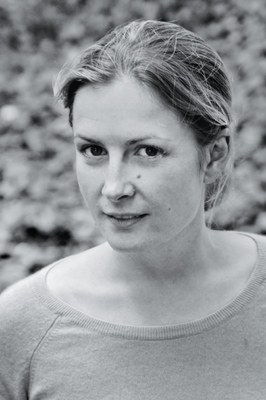Reviewed by David Sofield
Poet Tess Taylor ’00 writes about Thomas Jefferson, Bombay, Berkeley—and herself[Poetry] Tess Taylor’s The Forage House (Red Hen Press) is an affecting collection, ranging from the dailiness of El Cerrito, Calif., where she lives now, to Albemarle County, Va., where a long line of her ancestors has lived for centuries. That line includes Thomas Jefferson, who, as slave owner and gardener and much else, is the subject of the central section of the book, “A Letter to Thomas Jefferson from Monticello.” This nine-page, nine-part poem concludes with these words written to her eloquent relative: “ambitious foundering father I revere & hate & see myself in.” “Foundering father” is distinctly not a misprint; one appreciates the touch. To write that final line is of course to be ambitious oneself. Tess Taylor sets the bar high.

Some of Taylor’s most revealing self-portraits speak in the second person, providing a distance that clarifies.
Photo by Danielle Nelson Mourning
As in many first books of poems, seeing oneself is what these poems return to time and again. When the focus is not on the self, it is often on the places that formed it: the “Brooklyn commune room” (twice), where she was conceived; Madison and Berkeley, where her mother, an academic, worked; and Bombay, where her parents did archival research. Like a near-native, she is ready to tease teasable Berkeley: “Many people there build experimental gardens / & devote their lives to cultivating / the best kind of tomato.”
But, although she numbers herself among the “inheritors of absences,” it is in the Virginia of her Taylor and Randolph ancestors that she principally finds herself. The portraiture is rich and at times welcomely surprising: at one point, doing her own archival foraging in Virginia, she writes: “I feel heavy with wild namelessness.” At another, while in a church service in Charlottesville: “I went to worship. Felt / my uneasy white-girlishness as I rocked.” And then to Jefferson: “O hypocrite — you make me tired.” Little wonder, then, that at the very midpoint of the sequence she says to him, “You disappear behind / your multitude of portraits.”
Taylor herself does not disappear, in significant part because what may be her most revealing and effective self-portraits speak in the second person, providing a distance that clarifies. “Official History” begins:
You work as a journalist, pursuing legends
of other people. It is October; gold leaves fall
on your birthday. Little mysteries
swirl with you, a Tess —
now hunting out a dented spoon or crest,
some half-disguise by which to know yourself.
The side-glance at Hardy’s Tess is unmistakable, but it is trumped by the echo of two of Elizabeth Bishop’s most memorable lines: “you are an Elizabeth, / you are one of them.” Taylor caps her (and Bishop’s) italics with the strong rhyme, in a book in which rhyming is rare, on “crest.”
The next second-person self-portrait is more modest, as well as wittier.
You came
in ripped jeans from California and tasted
their seed, their curd, their underworld of 80 proof
or no proof, a difficult nut, cracked but rotten.
Historical proof may be hard to come by, but whisky’s proof is not.
Those couplets—the first one here, in its formal disparities, may be a knowing version of ripped jeans—are worn by most of Taylor’s poems. It is a measure that serves her, like many current poets, well. One thinks of the free-verse couplets in Louise Glück’s “Ancient Text.” At moments, Taylor’s self-portraiture indeed resembles Glück’s, but Taylor’s emerges from a sensibility less self-serious. The Forage House—which, as it should, at times makes a reader do some significant part of the work—is an appealing first book.
David Sofield is the Samuel Williston Professor of English at Amherst.